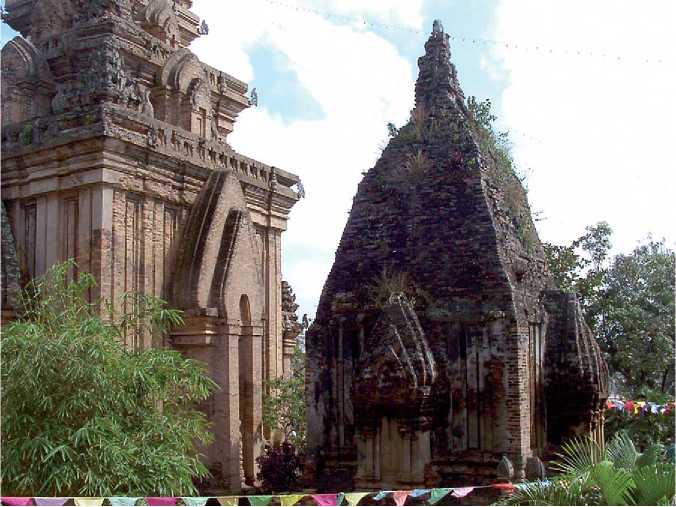The Cham civilization occupied the coastal plains of Vietnam from Saigon to the Hai Van Pass. Its people spoke an Austronesian language most akin to the languages of Borneo, and their ancestors probably settled this coastal strip during the first millennium BC. The territory of the Chams is divided into a series of restricted coastal enclaves, backed to the west by the Truong Son Cordillera. Cham centers are located at the estuaries of the major rivers that cross these coastal plains. The most southerly region of Champa lies from the eastern margins of the Mekong Delta to Cape Dinh, an inhospitable stretch of coastline with thin, sandy soils. Between Cape Dinh and Cape
Nay, there are three well-watered valleys separated by low passes, an area known to the Chams as Panduranga. North of Cape Dinh, the coastal strip broadens into a plain about 70 x 70 km2 in extent. There are many sites here in a region known to the Chams as Vijaya. The region of Amaravati lies between the Hai Van Pass and Quy Nhon, and was the dominant area of Cham political centrality. It has a reasonable area of land available for agriculture, and several well-sheltered harbors. The last area lies north of the Hai Van Pass, with most archaeological sites being concentrated in the vicinity of Quang Tri. The relative importance and political reach of these polities named in the inscriptions almost certainly changed markedly over time.
It is most unlikely that Champa was ever a unified state. Early records provide the names of the component parts of this civilization. We find reference to Amaravati and Vijaya. Kauthara was first mentioned in an inscription from Pa Nagar set up by King Satyavarman in AD 784. A kingdom known as Panduranga was recorded in an inscription from Po Nagar, dated to 817 AD, which describes its ruler.
My Son was the great ceremonial center of Amara-vati. It comprises a series of brick shrines set out in seven walled groups with many outliers. It was founded at least as early as the fifth century AD under a ruler known as Bhadravarman. King Vikrantavarman initiated a major building program at My Son in the seventh century AD. The temples were built of brick, and the exterior surfaces bore strip pilasters, false doors, and window niches. Further temples were erected at least until the reign of Jaya Indravarman toward the end of the eleventh century. Temple E1 is particularly notable for the presence of fine Cham sculptures that belong to the early seventh century. The inspiration of Indian art and religion is seen in a carved sandstone pediment over 2 m wide, illustrating Vishnu recumbent on the ocean of eternity, represented by a seven-headed serpent. A bearded ascetic watches the god from his side, and two figures grasp snakes in bird’s talons beyond his head and feet. The temple within was dominated by a large linga, a phallic symbol, representing Shiva, which stood on a richly ornamented pedestal. Access to the top of this platform, which represented Mount Kailasa (the home of Shiva), was by three steps. The outer walls of the pedestal incorporate a series of carved reliefs. One of these is regarded by Guillon as a masterpiece of Cham art, showing three dancers wearing rich ornaments and holding scarves. Their jewelry includes multiple necklaces, belts, armlets, and heavy ear disks. Free-standing sculptures were also recovered from My Son, the earliest coming from temple E5, and dating to the late seventh century. It portrays Ganesha, the elephant god of wisdom. Again, Indian inspiration is apparent in this fine statue, which stands almost a meter high. Ganesha is portrayed with four arms, and he holds a rosary, an axe, a bowl of sweets, and the root of a plant which elephants are known to appreciate. He wears a complex decorated belt and a tiger skin. A second statue of Ganesha from temple B3 stresses again the local attachment to this god. In this case, the elephant is portrayed as seated.
Dong Duong is a second major center of Amara-vati. It is a very large complex, measuring 1.5 km from east to west, and was probably built by King Bhadravarman in honor of his predecessor, King Jaya Indravarman, in the late ninth century AD. The was a temple designed for the worship of the Buddha. It contains a huge statue of the seated Buddha, standing over 1.5 m high, which was discovered in 1935 in the hall of the Dong Duong monastery. Another large statue depicts a monk holding a lotus in front of him with both hands, and also came from the monastic hall. A third fine statue from this site shows a guardian of the law. A dvarapala is a door guardian, and there were eight of these at Dong Duong. They are massive and forbidding, standing over 2 m in height. Each one tramples on an animal or person, and flourishes a sword.
Po Nagar is the major center of Kauthara, the most southerly polity of the Cham civilization (Figure 11). Six brick sanctuaries are built on an eminence that commands a major estuary. There is a lengthy history of construction, commencing at least in the seventh century AD with a wooden temple that was destroyed by fire in AD 774. The northwestern tower was built in AD 813, and further sanctuaries were added until

Figure 11 The Cham temple of Po Nagar commands a strategic estuary on the coast of Southern Vietnam.
AD 1256. King Jaya Harivarmadeva set up an inscription in AD 1160, claiming victory over the Khmer and Vietnamese, as well as the Cham kingdoms of Vijaya, Amaravati, and Panduranga. The site is located so that it could control sea traffic from China south to the states of mainland and island Southeast Asia.
Chinese records contain many references to the Chams, who appear as a constant irritant to the maintenance of peace on their southern frontier. However, it was the expulsion of the Chinese from the Red River delta area by the Vietnamese that brought doom to the Chams. Progressively, the Vietnamese pushed south along the coastal corridor, destroying the Cham civilization. Today, Cham speakers survive in small communities within the state of Vietnam.




 World History
World History









